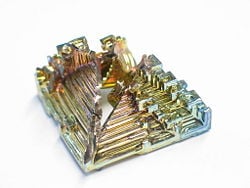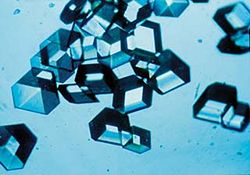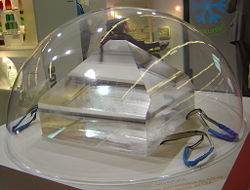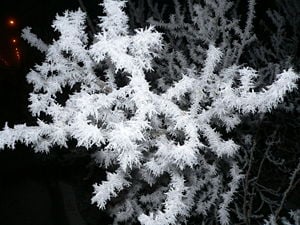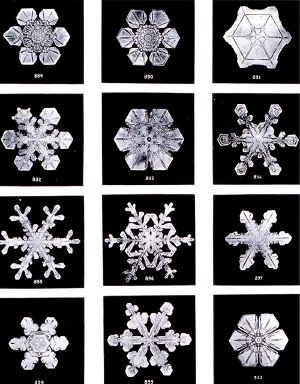Difference between revisions of "Crystal" - New World Encyclopedia
| Line 25: | Line 25: | ||
Some crystalline materials may exhibit special electrical properties, such as the [[ferroelectric effect]] or the [[piezoelectricity|piezoelectric effect]]. Additionally, [[light]] passing through a crystal is often bent in different directions, producing an array of colors; [[crystal optics]] is the study of these effects. In periodic [[dielectric]] structures a range of unique optical properties can be expected as described in [[photonic crystal]]s.<?> | Some crystalline materials may exhibit special electrical properties, such as the [[ferroelectric effect]] or the [[piezoelectricity|piezoelectric effect]]. Additionally, [[light]] passing through a crystal is often bent in different directions, producing an array of colors; [[crystal optics]] is the study of these effects. In periodic [[dielectric]] structures a range of unique optical properties can be expected as described in [[photonic crystal]]s.<?> | ||
| − | ==Historical and mythical uses== | + | == Crystallization == |
| + | |||
| + | '''Crystallization''' is the (natural or artificial) process of formation of solid [[crystal]]s from a [[wiktionary:Homogeneous|homogeneous]] [[solution]]. Crystallization is also a chemical solid-liquid separation technique. | ||
| + | |||
| + | [[image:Snow crystallization in Akureyri 2005-02-26 19-03-37.jpeg|300px|right|thumb|Frost crystallization on a shrub.]] | ||
| + | |||
| + | The crystallization process consists of two major events, '''[[nucleation]]''' and '''[[crystal growth]]'''. | ||
| + | |||
| + | <!-- ''Nucleation'' is the onset of a phase transition in a small but stable region. The phase transition can be the formation of a bubble or of a crystal from a liquid. Creation of liquid dropplets in saturated vapour is also characterised by nucleation (see Cloud condensation nuclei). —> | ||
| + | ''Nucleation'' is the step where the solute molecules dispersed in the solvent start to gather to create clusters in the nanometer scale (elevating solute concentration in a small region) as to become stable under the current operating conditions. | ||
| + | These stable clusters constitute the nuclei. However when the clusters are not stable, they redissolve. Therefore, the clusters need to reach a critical size in order to become stable nuclei. Such critical size is dictated by the operating conditions (temperature, supersaturation, irregularities, etc.). It is at the stage of nucleation that the atoms arrange in a defined and periodic manner that defines the [[crystal structure]] — note that "crystal structure" is a special term that refers to the internal arrangement of the atoms, but NOT the physical external macroscopic properties of the crystal, size and shape. | ||
| + | |||
| + | The ''crystal growth'' is the subsequent growth of the nuclei that succeed in achieving the critical cluster size. Subsequently, nucleation and growth continue to occur simultaneously while the supersaturation exists. Supersaturation is the driving force of the crystallization, hence the rate of nucleation and growth is driven by the existing supersaturation in the solution. Depending upon the conditions, either nucleation or growth may be predominant over the other, and as a result, crystals with different sizes and shapes are obtained (Control of crystal size and shape constitutes one of the main challenges in industrial manufacturing, such as for pharmaceuticals). Once the supersaturation is exhausted, the solid-liquid system reaches the equilibrium and the crystallization is completed, unless the operating conditions are modified from equilibrium as to supersaturate the solution again. | ||
| + | |||
| + | === Crystallization in nature === | ||
| + | [[Image:SnowflakesWilsonBentley.jpg|thumb|right|Snowflakes are a well-known example of crystals in nature. Subtle differences in crystal growth conditions result in different geometries.]] | ||
| + | |||
| + | There are many examples of crystallization in [[nature]]. Examples include the formation of: | ||
| + | * mineral crystals (including [[gemstone]]s); | ||
| + | * stalactites and stalagmites; | ||
| + | * snowflakes. | ||
| + | |||
| + | === Artificial methods === | ||
| + | For crystallization to occur the solution must be [[supersaturated]]. This means that the solution has to contain more [[solute]] entities (molecules or [[ion]]s) dissolved than it would contain under the equilibrium (saturated solution). This can be achieved by various methods, with 1) solution cooling, 2) addition of a second solvent to reduce the solubility of the solute (technique known as anti-solvent or drown-out), 3) chemical reaction and 4) change in pH being the most common methods used in industrial practice. Other methods, such as solvent evaporation, can also be used. | ||
| + | |||
| + | ==Historical and mythical uses of crystals== | ||
| + | |||
According to [[Bahya_ben_Asher|Rebbenu Bachya]], the word "Achlmah" in the verse [[Exodus]] 28:19 means "Crystal" and was the stone on the [[Ephod]] representing the tribe of [[Gad]]. | According to [[Bahya_ben_Asher|Rebbenu Bachya]], the word "Achlmah" in the verse [[Exodus]] 28:19 means "Crystal" and was the stone on the [[Ephod]] representing the tribe of [[Gad]]. | ||
Crystals also figure or figured prominently as healing tools in a number of mythologies. | Crystals also figure or figured prominently as healing tools in a number of mythologies. | ||
| + | |||
| + | |||
== See also == | == See also == | ||
| Line 53: | Line 81: | ||
* [http://www.thecrystalweb.org/ A virtual museum about the crystal] | * [http://www.thecrystalweb.org/ A virtual museum about the crystal] | ||
* [http://giantcrystals.strahlen.org The Giant Crystal Project - documenting the largest crystals and crystal aggregates known to exist] | * [http://giantcrystals.strahlen.org The Giant Crystal Project - documenting the largest crystals and crystal aggregates known to exist] | ||
| + | *[http://www.cheresources.com/cryst.shtml Industrial Crystallization] | ||
| + | *[http://www.rigakumsc.com/journal/Vol16.2.1999/cudney.pdf The first record of dumb luck protein crystallization] | ||
[[Category:Physical sciences]] | [[Category:Physical sciences]] | ||
| Line 58: | Line 88: | ||
[[Category:Earth sciences]] | [[Category:Earth sciences]] | ||
| − | {{ | + | {{credit2|Crystal|79916637|Crystallization|79521888}} |
Revision as of 01:32, 7 October 2006
- For other senses of this word, see crystal (disambiguation).
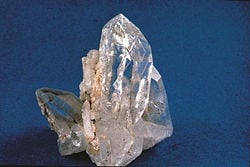
In chemistry and mineralogy, a crystal is a solid in which the constituent atoms, molecules, or ions are packed in a regularly ordered, repeating pattern extending in all three spatial dimensions. The scientific study of crystals and crystal formation is called crystallography.
Generally, crystals form when they undergo a process of solidification.<crystallization?> Under ideal conditions, the result may be a single crystal, with all the atoms of the solid fitting into the same crystal structure. Generally, however, many crystals form simultaneously during solidification, leading to a polycrystalline solid. For example, most metals encountered in everyday life are polycrystals. In addition, crystals are often symmetrically intergrown to form crystal twins.
Which crystal structure will be formed from a fluid depends on the chemistry of the fluid, the conditions under which it is being solidified, and the ambient pressure. The process of forming a crystalline structure is often referred to as crystallization.
While the cooling process usually results in the generation of a crystalline material, under certain conditions, the fluid may be frozen in a noncrystalline state. In most cases, this involves cooling the fluid so rapidly that atoms cannot travel to their lattice sites before they lose mobility. A noncrystalline material, which has no long-range order, is called an amorphous, vitreous, or glassy material. It is also often referred to as an amorphous solid, although there are distinct differences between solids and glasses: most notably, the process of forming a glass does not release the latent heat of fusion. For this reason, many scientists consider glassy materials to be viscous liquids rather than solids, although this is a controversial topic.
Crystalline structures occur in all classes of materials, with all types of chemical bonds. Almost all metals exist in a polycrystalline state; amorphous or single-crystal metals must be produced synthetically, often with great difficulty. Ionically bonded crystals can form upon solidification of salts, either from a molten fluid or when it condenses from a solution. Covalently bonded crystals are also common, notable examples being diamond, silica, and graphite. Polymer materials generally form crystalline regions, but the lengths of the molecules usually prevents complete crystallization. Weak Van der Waals forces can also play a role in a crystal structure; for example, this type of bonding loosely holds together the hexagonal-patterned sheets in graphite.
Most crystalline materials have a variety of crystallographic defects. The types and structures of these defects can have a profound effect on the properties of the materials.
While the term "crystal" has a precise meaning within materials science and solid-state physics, colloquially "crystal" refers to solid objects that exhibit well-defined geometric shapes, often pleasing in appearance. In this sense of the word, many types of crystals are found in nature. The shape of these crystals depends on the types of molecular bonds between the atoms to determine the structure, as well as on the conditions under which they formed. Snowflakes, diamonds, and common salt are common examples of crystals.
Some crystalline materials may exhibit special electrical properties, such as the ferroelectric effect or the piezoelectric effect. Additionally, light passing through a crystal is often bent in different directions, producing an array of colors; crystal optics is the study of these effects. In periodic dielectric structures a range of unique optical properties can be expected as described in photonic crystals.<?>
Crystallization
Crystallization is the (natural or artificial) process of formation of solid crystals from a homogeneous solution. Crystallization is also a chemical solid-liquid separation technique.
The crystallization process consists of two major events, nucleation and crystal growth.
Nucleation is the step where the solute molecules dispersed in the solvent start to gather to create clusters in the nanometer scale (elevating solute concentration in a small region) as to become stable under the current operating conditions. These stable clusters constitute the nuclei. However when the clusters are not stable, they redissolve. Therefore, the clusters need to reach a critical size in order to become stable nuclei. Such critical size is dictated by the operating conditions (temperature, supersaturation, irregularities, etc.). It is at the stage of nucleation that the atoms arrange in a defined and periodic manner that defines the crystal structure — note that "crystal structure" is a special term that refers to the internal arrangement of the atoms, but NOT the physical external macroscopic properties of the crystal, size and shape.
The crystal growth is the subsequent growth of the nuclei that succeed in achieving the critical cluster size. Subsequently, nucleation and growth continue to occur simultaneously while the supersaturation exists. Supersaturation is the driving force of the crystallization, hence the rate of nucleation and growth is driven by the existing supersaturation in the solution. Depending upon the conditions, either nucleation or growth may be predominant over the other, and as a result, crystals with different sizes and shapes are obtained (Control of crystal size and shape constitutes one of the main challenges in industrial manufacturing, such as for pharmaceuticals). Once the supersaturation is exhausted, the solid-liquid system reaches the equilibrium and the crystallization is completed, unless the operating conditions are modified from equilibrium as to supersaturate the solution again.
Crystallization in nature
There are many examples of crystallization in nature. Examples include the formation of:
- mineral crystals (including gemstones);
- stalactites and stalagmites;
- snowflakes.
Artificial methods
For crystallization to occur the solution must be supersaturated. This means that the solution has to contain more solute entities (molecules or ions) dissolved than it would contain under the equilibrium (saturated solution). This can be achieved by various methods, with 1) solution cooling, 2) addition of a second solvent to reduce the solubility of the solute (technique known as anti-solvent or drown-out), 3) chemical reaction and 4) change in pH being the most common methods used in industrial practice. Other methods, such as solvent evaporation, can also be used.
Historical and mythical uses of crystals
According to Rebbenu Bachya, the word "Achlmah" in the verse Exodus 28:19 means "Crystal" and was the stone on the Ephod representing the tribe of Gad.
Crystals also figure or figured prominently as healing tools in a number of mythologies.
See also
- Atomic packing factor
- Crystal habit
- Crystal structure
- Crystallite
- Crystallization
- Liquid crystal
- Quasicrystal
- Seed crystal
- Single crystal
- Crystal ball
- Crystal oscillator
- Crystal radio
External links
- Chemistry of Crystals
- Introduction to Crystallography and Mineral Crystal Systems
- Crystallographic Teaching Pamphlets
- Crystal Lattice Structures
- A virtual museum about the crystal
- The Giant Crystal Project - documenting the largest crystals and crystal aggregates known to exist
- Industrial Crystallization
- The first record of dumb luck protein crystallization
Credits
New World Encyclopedia writers and editors rewrote and completed the Wikipedia article in accordance with New World Encyclopedia standards. This article abides by terms of the Creative Commons CC-by-sa 3.0 License (CC-by-sa), which may be used and disseminated with proper attribution. Credit is due under the terms of this license that can reference both the New World Encyclopedia contributors and the selfless volunteer contributors of the Wikimedia Foundation. To cite this article click here for a list of acceptable citing formats.The history of earlier contributions by wikipedians is accessible to researchers here:
The history of this article since it was imported to New World Encyclopedia:
Note: Some restrictions may apply to use of individual images which are separately licensed.
